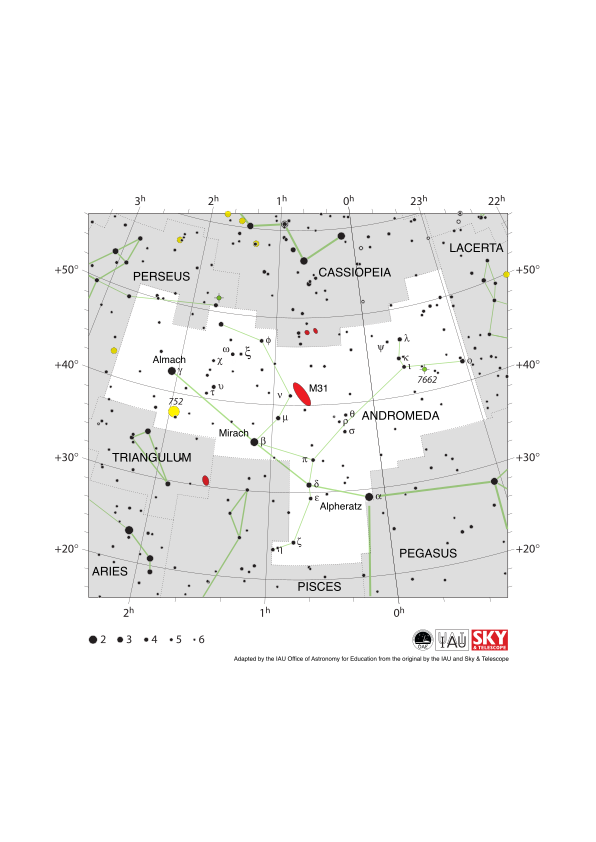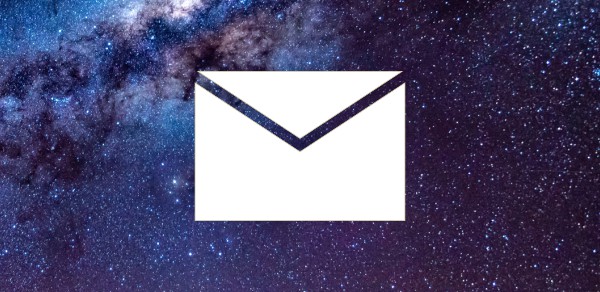This page describes an image Andromeda Constellation Map
Download PDF File (PDF file 184.46 kB)
Diagram caption:
The constellation Andromeda showing the bright stars and surrounding constellations. Andromeda is surrounded by (going clockwise from the top) Cassiopeia, Lacerta, Pegasus, Pisces, Aries, Triangulum and Perseus. The brightest star in Andromeda (Alpheratz) is in the lower part of the constellation. Together with three stars in Pegasus it forms the asterism known as the "Great Square of Pegasus". The next two bright stars in the constellation (Mirach and Almach) form a line extending north-east from Alpheratz.
Andromeda is a northern constellation and is most visible in the evenings in the Northern Hemisphere autumn. It is visible from all of the Northern Hemisphere and most temperate regions of the Southern Hemisphere but is not visible from Antarctic and Subantarctic regions.
The most famous object in Andromeda, the Andromeda Galaxy is marked here with a red ellipse and its Messier catalog number M31.
The yellow circle on the left marks the position of the open cluster NGC 752 and the green circle on the right marks NGC 7662 (the blue snowball nebula), a planetary nebula.
The y-axis of this diagram is in degrees of declination with north as up and the x-axis is in hours of right ascension with east to the left. The sizes of the stars marked here relate to the star's apparent magnitude, a measure of its apparent brightness. The larger dots represent brighter stars. The Greek letters mark the brightest stars in the constellation. These are ranked by brightness with the brightest star being labeled alpha, the second brightest beta, etc., although this ordering is not always followed exactly. The dotted boundary lines mark the IAU's boundaries of the constellations and the solid green lines mark one of the common forms used to represent the figures of the constellations. Neither the constellation boundaries, nor the lines joining the stars appear on the sky.
Diagram credit: Adapted by the IAU Office of Astronomy for Education from the original by IAU/Sky & Telescope. Bildnachweisbindung
Diagram translation status: Not yet approved by a reviewer
Zugehörige Glossarbegriffe:
Andromeda
, Andromedagalaxie
, Deklination
, Offener Sternhaufen
, Planetarischer Nebel
, Rektaszension (RA)
, Scheinbare Helligkeit
, Sternbild
Categories:
Naked Eye Astronomy
Diagram license: Creative Commons Namensnennung 4.0 International (CC BY 4.0) Creative Commons Namensnennung 4.0 International (CC BY 4.0) icons
In Other Languages
Englisch: Andromeda Constellation MapPortuguese BR: Mapa da Constelação de Andrômeda
Italienisch: Mappa della costellazione di Andromeda
Spanisch: Mapa de la constelación de Andrómeda
Arabisch: خريطة كوكبة أندروميدا
Französisch: Carte de la constellation d'Andromède
The diagram captions presented on the OAE website were written, translated and reviewed by a collective effort from the OAE, the OAE Centers and Nodes, the OAE National Astronomy Education Coordinators (NAECs) and other volunteers. You can find a full list of credits for our translation project here. All media file captions are released under a Creative Commons CC BY-4.0 license and should be credited to "IAU OAE". The media files themselves may have different licenses (see above) and should be credited as listed above under "credit".
If you notice a error in this diagram or its caption then please get in touch.









